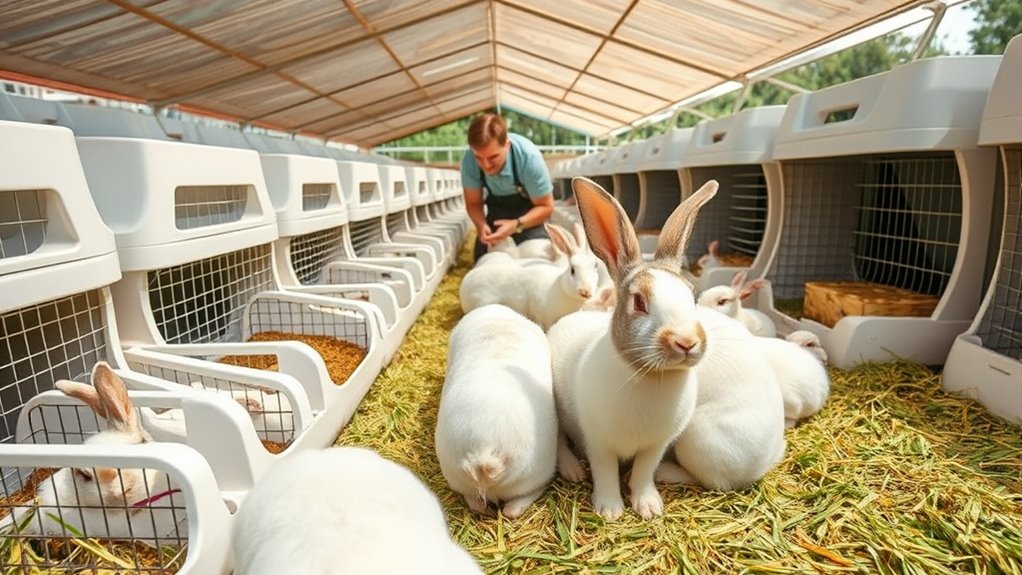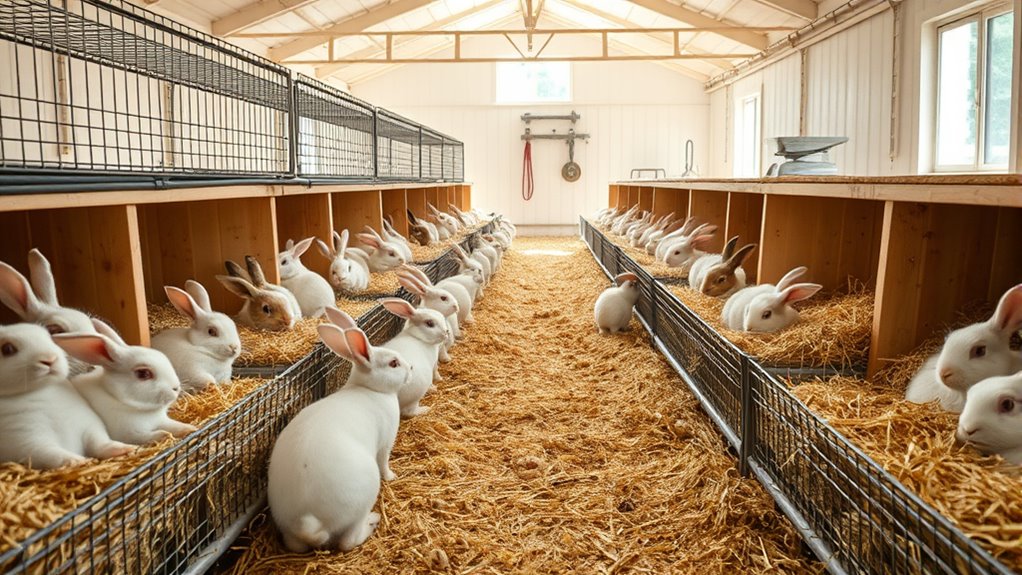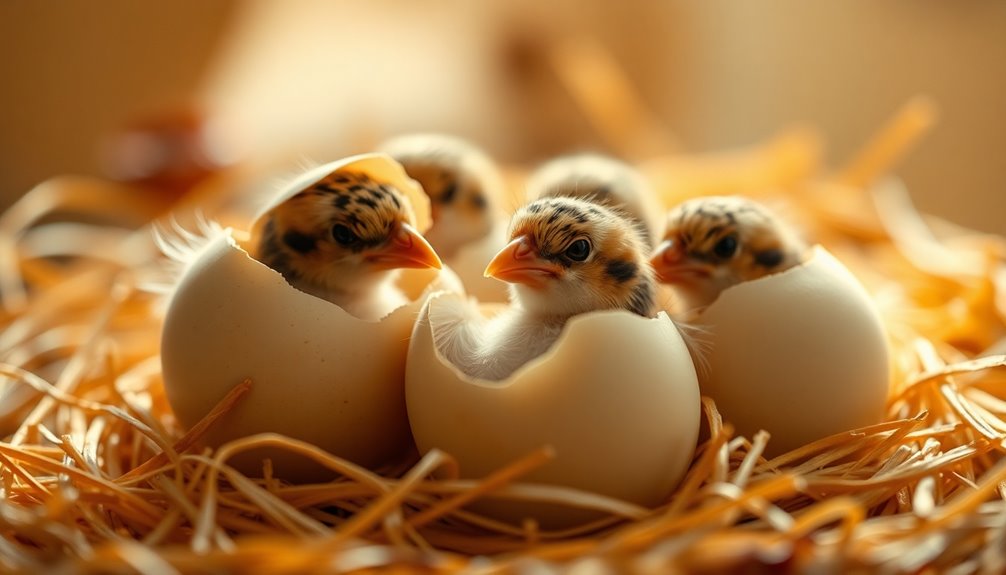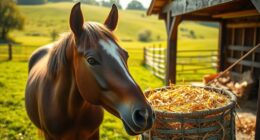To start your rabbitry, ensure you provide secure, well-ventilated enclosures with sturdy materials and enough space for exercise. Carefully select healthy breeders and plan your breeding to improve desirable traits. Maintain a balanced diet of high-quality hay, vegetables, and pellets for maximum health and meat quality. Keep cages clean, monitor animals regularly, and offer proper housing to prevent stress and illness. If you keep at it, you’ll discover how to maximize health, growth, and meat production.
Key Takeaways
- Provide secure, well-ventilated enclosures with ample space and cleanliness to ensure rabbit health and comfort.
- Carefully select healthy breeders and monitor pregnancies for successful, stress-free reproduction.
- Offer a balanced diet with high-quality hay, vegetables, and pellets to support growth and meat quality.
- Maintain regular health checks and sanitation to prevent disease and promote overall wellbeing.
- Focus on proper housing, nutrition, and management practices to maximize meat production efficiency.

Starting a rabbitry can be a rewarding venture, but it’s important to understand the basics before you get started. One of the most critical aspects is ensuring your rabbits stay healthy. Good rabbit health relies heavily on proper nutrition and a clean environment. You’ll want to provide a balanced diet that includes high-quality hay, fresh vegetables, and a formulated pellet. This diet supplies the necessary fiber, vitamins, and minerals needed for their well-being. Avoid feeding too many treats or sugary foods, as these can upset their digestive system and lead to health issues. Regularly monitoring your rabbits for signs of illness, such as lethargy, changes in appetite, or abnormal behavior, is essential. Maintaining a clean living space helps prevent disease and keeps your rabbits comfortable. Clean cages frequently, remove waste daily, and ensure proper ventilation to minimize respiratory problems. When it comes to housing, rabbits require secure, well-ventilated enclosures that protect them from extreme weather and predators. Use sturdy materials for cages and provide enough space for exercise, as rabbits are active animals that need movement to stay healthy. Adding hay racks and nesting boxes can help replicate their natural environment, encouraging natural behaviors and reducing stress. Proper housing also makes it easier to manage rabbit health by keeping their living areas clean and free of parasites. Additionally, rabbit housing design plays a significant role in preventing injuries and promoting comfort. Breeding rabbits demands careful planning and attention to genetics, but it also requires a solid understanding of their needs. Select breeders that are healthy and have desirable traits, and always check their health history before breeding. Good nutrition plays a crucial role here; well-fed rabbits are more likely to produce healthy litters. When breeding, keep a close eye on your does during pregnancy and ensure they have ample nutritious food and a quiet, comfortable environment. Proper nutrition continues through the nursing period, supporting both the mother and her kits. Meat production from rabbits depends on consistent management practices, including choosing the right breeds, providing ideal nutrition, and maintaining good health. As your rabbits grow, guarantee they receive enough high-quality food to promote rapid, healthy growth. Regular health checks are essential to prevent common issues like parasites or infections that could affect meat quality. Adequate housing and proper care not only maximize growth rates but also improve the overall quality of the meat you produce. Whether you’re raising rabbits for hobby, breeding, or meat, understanding these foundational elements—housing, breeding, nutrition, and health—is key to success. With attention to these details, you’ll develop a thriving rabbitry that’s both productive and sustainable.
Frequently Asked Questions
How Do I Prevent My Rabbits From Escaping Their Enclosure?
To prevent your rabbits from escaping, guarantee enclosure security by checking for and fixing any weak spots, gaps, or holes regularly. Use sturdy materials like wire mesh with small openings to prevent escape and reinforce the enclosure door with secure latches. Regularly inspect and maintain the structure, and consider adding a double-door system for extra escape prevention. These steps will keep your rabbits safely contained and happy.
What Are the Signs of a Healthy Breeding Pair?
You’ll notice a healthy breeding pair exhibits clear signs of pairing bonding, like grooming and cuddling. They show active mating behaviors, such as mounting and nesting. Their coats look shiny, and they have a healthy appetite. You might also see gentle interactions and mutual grooming, indicating a strong bond. These signs suggest they’re prepared for successful breeding, helping ensure good offspring and a stable pair over time.
How Often Should I Rotate My Meat Rabbits’ Diet?
You should rotate your meat rabbits’ diet every few days to keep things interesting—after all, they love a little variety, right? In reality, a consistent rabbit diet is best, with a typical feed rotation every 1-2 weeks. This prevents digestive issues and ensures they get balanced nutrition. Stick to fresh hay, pellets, and veggies, and your rabbits will stay healthy and happy, craving their meals daily.
What Environmental Factors Influence Rabbit Reproduction Rates?
Environmental factors like temperature, light, and humidity directly affect your rabbit reproduction rates. You can improve outcomes through genetic selection for fertility and by optimizing nutrition to support reproductive health. Keep the environment cool and well-ventilated, and guarantee your rabbits get balanced diets rich in essential nutrients. By managing these factors carefully, you’ll boost conception rates and overall productivity, making your rabbitry more successful.
How Can I Minimize Stress for My Rabbits During Transport?
To tame transport tension, take thoughtful steps to guarantee transportation safety and stress reduction techniques. Keep rabbits calm by providing quiet, comfortable carriers with ample ventilation. Minimize movement by handling them gently and avoiding sudden shifts. Maintain consistent temperatures and avoid loud noises during transit. Planning precise routes and limiting travel time also help, making the journey less stressful and more secure for your rabbits.
Conclusion
Think of your rabbitry as a garden—you’re the gardener tending to each plant with care and patience. Just as a garden flourishes with proper watering, pruning, and nurturing, your rabbits thrive when given the right housing, breeding, and care. Remember, a well-tended garden yields the sweetest harvest. So, stay attentive and dedicated, and your rabbitry will blossom into a rewarding oasis, reminding you that patience and effort turn simple seeds into something truly fruitful.










